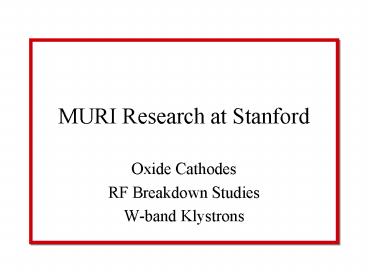MURI Research at Stanford - PowerPoint PPT Presentation
1 / 29
Title: MURI Research at Stanford
1
MURI Research at Stanford
- Oxide Cathodes
- RF Breakdown Studies
- W-band Klystrons
2
Aerial photograph of SLAC - SPEAR and SSRL are
near center of picture.
3
Photograph of 75 MW PPM klystron
4
Simulated Vo 490 kV, Io 275 A, Po 84 MW,
? 62.7 Measured Vo 490 kV, Io 275 A, Po
78 MW, ? 60, tp 2.8 ?s
Simulation of X-band PPM klystron using 2-D MAGIC
5
(No Transcript)
6
(No Transcript)
7
Cathodic Arc-Deposited
OCs
Traditional vs.
8
Sketch of plasma gun
9
Photograph of dual plasma gun setup with
macroparticle filters
10
Graphs showing performance of plasma deposited
oxide cathodes
11
Schematic of laser, deposition chamber, and beam
path
12
Lambda Physik excimer laser for plasma deposition
13
RF Breakdown Motivation
- Pulse shortening in HPM devices limits pulse
energy - SLACs 11.424 GHz klystrons require complex
multi-gap output cavities to avoid breakdown - Pulse compressors, mode converters, tees, and
linac sections for NLC must support 400 MW
pulses - Conditioning of high power sources, waveguides
and accelerator sections requires significant
time
14
Drawing of TM020 RF breakdown cavity
15
TM020 RF breakdown cavity with removable nose
shown in foreground.
16
Experimental setup to measure dark current and rf
breakdown dependence on vacuum and pulse length.
17
Experimental setup to measure dark current and rf
breakdown dependence on vacuum and pulse length.
18
Top Grain boundaries provide sites for
breakdown. Bottom Melting along grain
boundaries compared to total surface area.
19
Dark current is approximately the same after rf
processing with background pressure ranging over
five orders of magnitude. (Pulse length is 200
ns)
20
Maximum field strength before vacuum deteriorates
approximates a pulse length dependence
corresponding to the -1/3 power for unconditioned
and conditioned cavity noses.
21
SEM image of processed copper surface at 678 MV/m
22
Motivation for Klystrino Research
Develop High Average Power, Millimeter-Wave, RF
Sources Using Advanced Microfabrication Techniques
- Scientific/technical approaches
- LIGA fabrication of microwave circuits for
low-cost, high-volume production - Multiple devices on same substrate
- Outputs can be combined or phase controlled for
beam steering - Compact, lightweight modules can be combined for
increased output power
LIGA substrate with Wband klystrino, 91 GHz
accelerator, and Wband sheet beam klystron
23
Potential application for high average power
millimeter wave source
24
Solid model of LIGA circuit, substrate, and PPM
assembly
25
Aerial photograph of SPEAR and SSRL
26
W-band output circuit scaled to X-band
27
Section of LIGA substrate with klystrino
penultimate and output cavities
28
MAGIC simulation of W-band PPM klystron output
section
29
Solid model of klystrino 4-pack (4 kW average
power)































